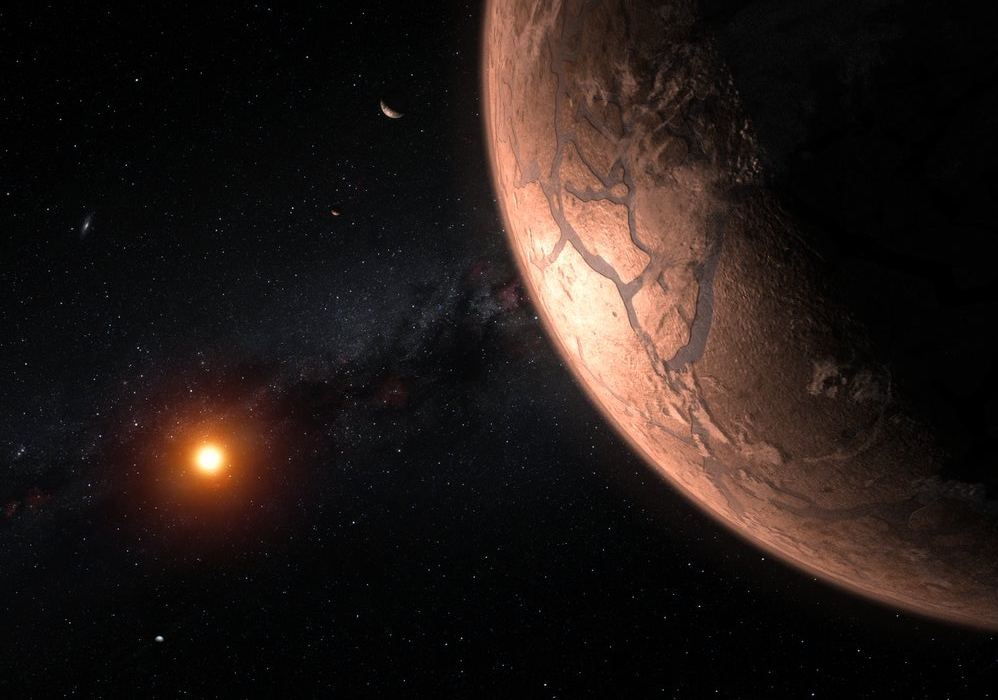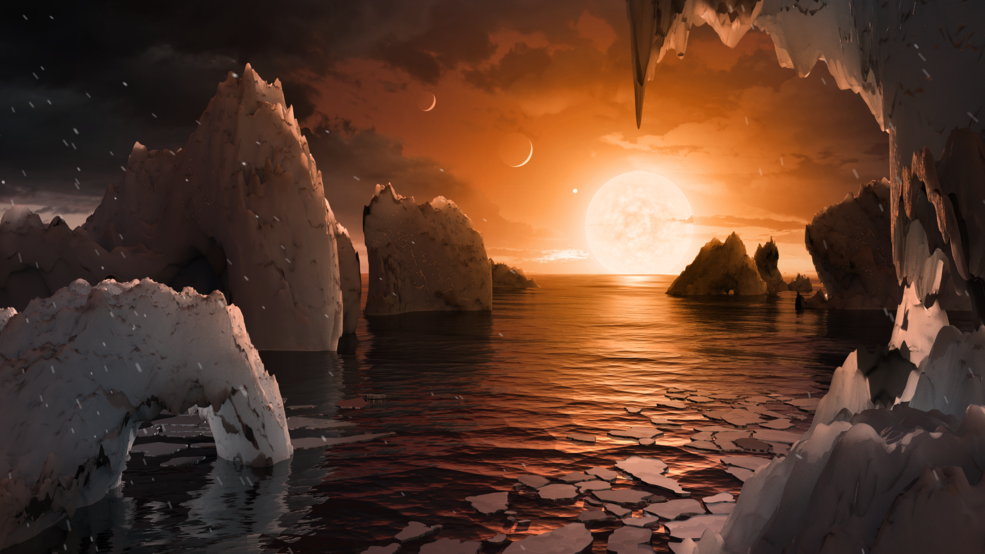In February of 2017, the scientific community rejoiced as NASA announced that a nearby star (TRAPPIST-1) had a system of no less than seven rocky planets! Since that time, astronomers have conducted all kinds of follow-up observations and studies in the hopes of learning more about these exoplanets. In particular, they have been attempting to learn if any of the planets located in the stars Habitable Zone (HZ) could actually be habitable.
Many of these studies have been concerned with whether or not the TRAPPIST-1 planets have sufficient water on their surfaces. But just as important is the question of whether or not any have viable atmospheres. In a recent study that provides an overview of all observations to date on TRAPPIST-1 planets, a team found that depending on the planet in question, they are likely to have good atmospheres, if any at all.
The study, which recently appeared in the journal *Space Science Reviews*, was conducted by an international team of researchers from the Geneva Astronomical Observatory (GAO), the University of Bern, the Laboratoire d’astrophysique de Bordeaux (LAB), the Astrophysics Research Group at Imperial College London, and the Laboratory for Atmospheric and Space Physics (LASP) at the University of Colorado.
Initially, it was a team of astronomers from the University of Liege, Belgium, who detected three of the system's exoplanets using Transit Spectroscopy (aka. the Transit Method). For this method, astronomers monitor stars for dips in their luminosity, which are the result of planets passing in front of the star (aka. transiting) relative to the observer.
The system was named TRAPPIST-1 in honor of the instrument used to detect them, which was the Transiting Planets and Planetesimals Small Telescope (TRAPPIST) located at the ESO's La Silla Observatory in Chile and the Observatoire de l'Oukaïmeden in Morocco. In February of 2017, the existence of four more exoplanets were confirmed, as well as the fact that three were orbiting with the star's HZ.
Ever since then, the TRAPPIST-1 system has been considered an excellent candidate by astronomers for exoplanet research. There are a number of reasons for this, which Martin Turbet (a postdoctoral researcher at the GAO and the lead author on the study) explained to Universe Today via email:
"The TRAPPIST-1 system is very well-suited for habitability studies because it is the planetary system made of potentially habitable exoplanets that is easiest to observe and thus characterize with telescopes. This is mainly due to the fact that (1) the TRAPPIST-1 system is very nearby (39 light years from us), (ii) the planets are transiting (frequently) in front of their star, and (iii) the host star TRAPPIST-1 is an ultra-cool dwarf with an extremely small radius."
In short, having seven exoplanets around a star means that there will be plenty of opportunities to spot them making transits in front of the star. On these occasions, astronomers are able to gather spectra from the planet as light from the star passes around the planet and through its atmosphere (a process known as transmission spectroscopy). Scientists are then able to examine this data to determine what chemical elements are present.
Because TRAPPIST-1 is an M-type (red dwarf) star - which are low in mass, cool, and relatively dim compared to other types of stars - the dips in luminosity that are caused by planetary transits are comparatively large. This property makes the transmission spectroscopy technique much easier to perform for any rocky planets in orbit, which applies to all seven planets in the TRAPPIST-1 system.
However, not all of the research conducted thus far has been very encouraging. In fact, multiple studies have been conducted that indicated that for some of the TRAPPIST-1 planets, water might make up a large part of their mass (making them " water worlds "). On top of that, there's the nature of red dwarf stars, which are prone to flare-ups that could wreak havoc on their planets' atmospheres.
However, other studies have found that exoplanets orbiting red dwarfs could still be habitable as long as they had sufficient atmospheres and cloud cover to deal with the radiation. To assess the likelihood that the TRAPPIST-1 planets had such atmospheres, Turbet and his colleagues considered all of the data that has been obtained on the TRAPPIST-1 system to date.
This includes transit observations made of the planets, as well as density measurements, transmission spectroscopy, the system's irradiation environment, theories on planetary formation and migration, the planets' orbital stability, climate modeling, and models that consider how much gas the planets lose to space (aka. escape models).
"We reviewed all existing works on the topic, ranging from observations with the best telescopes available (Hubble Space Telescope, Spitzer Space Telescope, Very Large Telescope, etc.) to the most sophisticated theoretical models such as three-dimensional numerical climate models," said Turbet.
What they found was rather encouraging. For starters, they were able to determine that most of the TRAPPIST-1 planets didn't have cloud-free, low molecular weight atmospheres - similar to what Earth's primordial atmosphere was like. Second, they found compelling evidence that those planets that did have atmospheres were likely composed of elements that have higher atomic weights. Or as Turbet summarized:
"We determined that the seven TRAPPIST-1 planets are unlikely to have hydrogen-dominated atmospheres. We also suggested that the atmospheres (if present) of the TRAPPIST-1 planets are most likely to be carbon dioxide-dominated, oxygen-dominated, or water-dominated."
In other words, of the seven TRAPPIST-1 planets, those that have atmospheres are likely to have that kind that are favourable to life (at least, as we know it). That means carbon dioxide, an essential climate-stabilizer and necessary for photosynthetic organisms, oxygen gas, nitrogen, and volatile elements like water. It also includes cloud cover, which is not only an indication of water, but provides protection against stellar radiation.
Unfortunately, Turbet and his colleagues cannot say with confidence that the TRAPPIST-1 planets have atmospheres with all of these elements. This study does, however, place constraints on that possibility based on what we know about the system so far. In the end, knowing if any of the exoplanets in this system are habitable will have to wait on next-generation telescopes. As Turbet said:
"Next-generation missions – in particular the James Webb Space Telescope and the near-infrared ground-based spectrographs – will have the power to detect ‘heavy’ molecules such as carbon dioxide, oxygen, methane, etc. and thus they may have the potential to determine whether or not the TRAPPIST-1 planets have atmospheres, and if so, what they are made of."
The JWST is scheduled to launch next year, whereas ground-based telescopes equipped next-generation spectrographs are expected to come online throughout this decade. With these and even more powerful instruments planned for the future, astronomers expect to finally know for certain if their is life beyond Earth in our corner of the galaxy!
*Further Reading: arXiv*
 Universe Today
Universe Today


